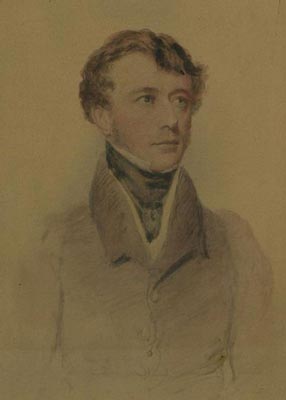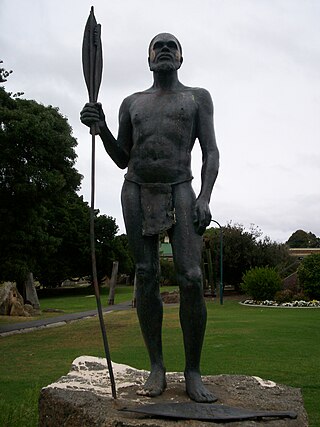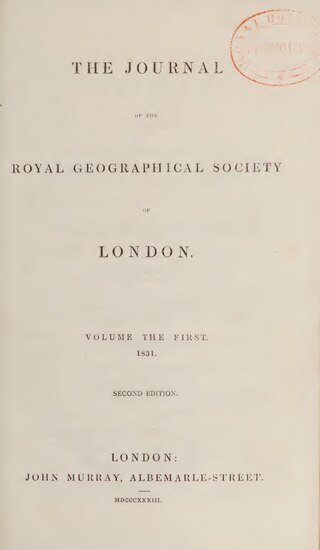
The coat of arms of Western Australia is the official coat of arms of the Australian state of Western Australia. It was granted by a royal warrant of Elizabeth II, Queen of Australia dated 17 March 1969.

The Noongar are Aboriginal Australian people who live in the south-west corner of Western Australia, from Geraldton on the west coast to Esperance on the south coast. There are 14 different groups in the Noongar cultural bloc: Amangu, Ballardong, Yued, Kaneang, Koreng, Mineng, Njakinjaki, Njunga, Pibelmen, Pindjarup, Wadandi, Whadjuk, Wiilman and Wudjari. The Noongar people refer to their land as Noongar boodja.
The human history of Western Australia commenced "over 50,000 years ago and possibly as much as 70,000 years ago" with the arrival of Aboriginal Australians on the northwest coast. The first inhabitants expanded across the east and south of the continent.

Yagan was an Aboriginal Australian warrior from the Noongar people. Yagan was pursued by the local authorities after he killed Erin Entwhistle, a servant of farmer Archibald Butler. It was an act of retaliation after Thomas Smedley, another of Butler's servants, shot at a group of Noongar people stealing potatoes and fowls, killing one of them. The government offered a bounty for Yagan's capture, dead or alive, and a young settler, William Keats, shot and killed him. He is considered a legendary figure by the Noongar.

Lieutenant-Colonel Frederick Chidley Irwin, KH was acting Governor of Western Australia from 1847 to 1848.

King George Sound is a sound on the south coast of Western Australia. Named King George the Third's Sound in 1791, it was referred to as King George's Sound from 1805. The name "King George Sound" gradually came into use from about 1934, prompted by new Admiralty charts supporting the intention to eliminate the possessive 's' from geographical names.

George Fletcher Moore was a prominent early settler in colonial Western Australia, and "one [of] the key figures in early Western Australia's ruling elite". He conducted a number of exploring expeditions; was responsible for one of the earliest published records of the language of the Aboriginal Australians of the Perth area; and was the author of Diary of Ten Years Eventful Life of an Early Settler in Western Australia.

Lieutenant Robert Dale was the first European explorer to cross the Darling Range in Western Australia.
Midgegooroo was an Aboriginal Australian elder of the Nyungar nation, who played a key role in Aboriginal resistance to white settlement in the area of Perth, Western Australia. Everything documented about Midgegooroo is mediated through the eyes of the colonisers, some of whom, notably G.F. Moore, Robert Menli Lyon and Francis Armstrong, derived their information from discussions with contemporary Noongar people, in particular the son of Midgegooroo, Yagan. Largely due to his exploits in opposing colonisation and his relationship with Lyon and Moore, Yagan has a much sharper historical profile than his father. Midgegooroo was executed by firing squad and without trial under the authority of Lieutenant Governor Frederick Irwin in 1833.

The exhumation of Yagan's head was the result of a geophysical survey and archaeological dig at a grave site in the Everton Cemetery, Liverpool in 1997. Yagan was an Aboriginal Australian warrior who was murdered in 1833 by British colonists, because of his resistance to the colonial British settlements in the Swan River Colony in Western Australia.

Whadjuk, alternatively Witjari, are Noongar people of the Western Australian region of the Perth bioregion of the Swan Coastal Plain.

Captain Mark John Currie RN played a significant role in the exploration of Australia and the foundation of the Swan River Colony, later named Western Australia.
The Havell family of Reading, Berkshire, England, included a number of notable engravers, etchers and painters, as well as writers, publishers, educators, and musicians. In particular, members of this family were among the foremost practitioners of aquatint; and had a long association with Indian art and culture. The family first came to notice through the brothers Luke Havell and Robert Havell the Elder ; along with their nephew Daniel Havell.
Noongar is an Australian Aboriginal language or dialect continuum, spoken by some members of the Noongar community and others. It is taught actively in Australia, including at schools, universities and through public broadcasting. The country of the Noongar people is the southwest corner of Western Australia. Within that region, many Noongar words have been adopted into English, particularly names of plants and animals.

Mokare was a Noongar Aboriginal man from the south-west corner of Australia, who was pivotal in aiding European exploration of the area.
This is a timeline of Aboriginal history of Western Australia.

Robert Barker was a painter from Kells, County Meath, Ireland, known for his panoramic paintings and for his coinage of the word "panorama".

Panoramic View of King George's Sound, Part of the Colony of Swan River is a panoramic hand-coloured print published in 1834 by Robert Havell, based on sketches by Robert Dale.

General view of the botany of the vicinity of Swan River is an 1831 scientific paper by Scottish botanist Robert Brown. It discusses the vegetation of the Swan River Colony, and comments on its affinities with other regions. It has been described as "an essential step taken in our knowledge of the boundaries of the SW province".

Calectasia cyanea, commonly known as the star of Bethlehem or blue tinsel lily, is a plant in the family Dasypogonaceae growing as a perennial herb and is endemic to the south–west of Western Australia. Restricted to a single population in Torndirrup National Park, it is critically endangered.














